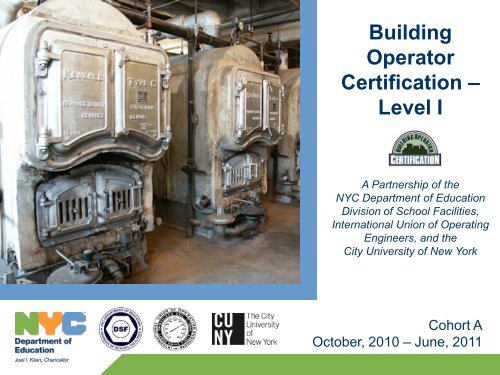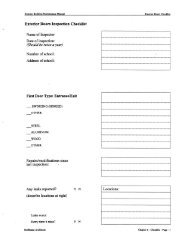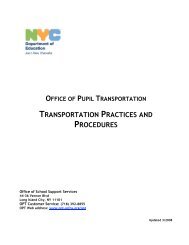Building Operator Certification â Level I - Opt-osfns.org
Building Operator Certification â Level I - Opt-osfns.org
Building Operator Certification â Level I - Opt-osfns.org
You also want an ePaper? Increase the reach of your titles
YUMPU automatically turns print PDFs into web optimized ePapers that Google loves.
<strong>Building</strong><br />
<strong>Operator</strong><br />
<strong>Certification</strong> –<br />
<strong>Level</strong> I<br />
A Partnership of the<br />
NYC Department of Education<br />
Division of School Facilities,<br />
International Union of Operating<br />
Engineers, and the<br />
City University of New York<br />
Cohort A<br />
October, 2010 – June, 2011
Welcome<br />
<strong>Building</strong> <strong>Operator</strong> <strong>Certification</strong><br />
for the NYC Department of Education<br />
Partners<br />
CUNY School of Professional Studies<br />
CUNY <strong>Building</strong> Performance Lab<br />
The BOC<br />
IUOE Local 891<br />
NYC DCAS<br />
2
Main Components of the Course<br />
• Operations & Maintenance Focus<br />
• Energy Efficiency with EnergyStar Portfolio<br />
Manager<br />
• Indoor Air & Environmental Quality<br />
• <strong>Certification</strong>s – BOC <strong>Level</strong> 1 and IUOE<br />
Indoor Air Quality Specialist<br />
3
Significance of <strong>Building</strong>s in New York City<br />
4
NYC Municipal <strong>Building</strong>s - Operations Goals<br />
The Long Term Sustainability Plan<br />
for the City of New York.<br />
• Within the Plan, the City commits to reducing<br />
energy use and greenhouse gas emissions<br />
from City operations 30% by 2017.<br />
5
NYC Municipal <strong>Building</strong>s and Operations Goals<br />
Schools comprise 40% of the City’s total<br />
municipal building square footage and about<br />
30% of its energy use<br />
Improved O&M could save millions of dollars<br />
in energy costs annually.<br />
Improved O&M could save 195,000 metric<br />
tons of greenhouse gas emissions annually<br />
Source: http://schools.nyc.gov/community/facilities/sustainability/default.htm<br />
6
NYC Municipal <strong>Building</strong>s and Operations Goals<br />
DOE’s Sustainability Initiative is lead by the<br />
Division of School Facilities to provide resources<br />
to optimize building operations and energy efficiency.<br />
7
The Significance of <strong>Building</strong> <strong>Operator</strong>s<br />
in the Performance Of <strong>Building</strong>s.<br />
“Operations is becoming recognized as key in the<br />
energy and indoor environmental performance of<br />
buildings.” (Turner 2008, Gifford, 2008).<br />
8
The Significance of <strong>Building</strong> <strong>Operator</strong>s<br />
The proper operation of building systems can only be<br />
provided by operators who have the skills to monitor<br />
and assess them.<br />
The building operator, on a managerial level, must be<br />
able to:<br />
• Assess the performance of buildings and systems.<br />
• Recognize and identify problems.<br />
• Measure, quantify and document the problems.<br />
• Support process of solutions and upgrades.<br />
9
Expected Outcomes of the Course<br />
Improvements in Performance of School<br />
Facilities from Enhanced O&M Practices<br />
−Indoor Air Quality<br />
−Energy Efficiency<br />
• as shown in EnergyStar Portfolio Manager<br />
−Reductions in Greenhouse Gas emissions<br />
10
Expected Outcomes of the Course<br />
Value to You, the Custodial Engineer<br />
• Enhanced knowledge and skills<br />
- mechanical / electrical systems and planned<br />
maintenance<br />
• Greater understanding of energy management<br />
- planning and implementing energy projects<br />
• Better ability to communicate in annual planning process<br />
and other forums<br />
• Get nationally recognized <strong>Certification</strong><br />
11
<strong>Building</strong> <strong>Operator</strong> <strong>Certification</strong> - BOC<br />
• <strong>Building</strong> <strong>Operator</strong> <strong>Certification</strong> is a nationally<br />
recognized training and certification program for<br />
building operators.<br />
• IUOE – Indoor Air Quality Specialist<br />
12
Dimensions of<br />
<strong>Building</strong> Performance<br />
….and Why They Matter<br />
13
Dimensions of <strong>Building</strong> Performance<br />
Inputs<br />
− Energy<br />
− Water<br />
Outputs<br />
− Indoor Environmental Quality (IEQ)<br />
• Indoor Air Quality (IAQ)<br />
• Illumination<br />
• Temperature<br />
• Acoustics<br />
− Comfort, Productivity and Health of<br />
Occupants<br />
14
Dimensions of <strong>Building</strong> Performance<br />
Measuring <strong>Building</strong> Performance<br />
“If you can’t measure it, you can’t manage it.”<br />
“What gets measured, gets managed.”<br />
15
Dimensions of <strong>Building</strong> Performance<br />
Measuring <strong>Building</strong> Performance<br />
Tools<br />
• Hand-held instruments & data-loggers<br />
• Web-based databases<br />
− EnergyStar Portfolio Manager for energy and water<br />
• <strong>Building</strong> Environmental Rating Systems<br />
− LEED building rating system – “EBOM”<br />
• Engineering Guidelines<br />
− Standards for lighting levels and power densities<br />
− Guidelines for ventilation air and thermal comfort<br />
16
Dimensions of <strong>Building</strong> Performance<br />
Measuring <strong>Building</strong> Performance<br />
American Society of Heating, Refrigeration and Airconditioning<br />
Engineers (ASHRAE)<br />
Performance Measurement Protocols for Commercial<br />
<strong>Building</strong>s<br />
Measurements in 6 Categories<br />
• Energy Efficiency<br />
• Water Efficiency<br />
• Thermal Comfort<br />
• Indoor Air Quality<br />
• Lighting Quality<br />
• Acoustics<br />
17
Dimensions of <strong>Building</strong> Performance<br />
Why They Matter<br />
• Evidence demonstrates the relationship between IAQ<br />
and human performance – in various settings,<br />
industrial, commercial and institutional<br />
• Schools with better physical conditions show<br />
improved academic performance<br />
18
Dimensions of <strong>Building</strong> Performance<br />
Why They Matter<br />
• Scientific evidence has long demonstrated an<br />
association between poor IAQ and respiratory<br />
health effects, including asthma.<br />
• Taking steps to improve the IAQ of schools<br />
is critical to bettering student health and academic<br />
performance.<br />
19
Dimensions of <strong>Building</strong> Performance<br />
Why They Matter<br />
• A growing body of research shows that IEQ, Indoor<br />
Environmental Quality, is linked to<br />
educational achievement and student performance.<br />
− Consistent with findings about productivity in industrial and commercial<br />
workplaces<br />
• The physical environment plays an important role in<br />
achieving the overall educational objectives of the<br />
school.<br />
Source: Guide to Operating and Maintaining<br />
EnergySmart Schools - US Dept of Energy<br />
20
EPA – IAQ Tools for Schools<br />
How to open “Tools for Schools” reading #1<br />
Go to the Home Page of “Tools for Schools”<br />
www.epa.gov/iaq/schools/index.html<br />
• See bottom of page “Products and Materials”<br />
• First Reading: “How does indoor air quality impact student<br />
health and performance”<br />
• See the “Key Findings Document”<br />
• See the left side bar and click on<br />
“Evidence from Scientific Literature”<br />
21






![Outlook Web Access [PDF] - Opt-osfns.org](https://img.yumpu.com/37391296/1/190x245/outlook-web-access-pdf-opt-osfnsorg.jpg?quality=85)









